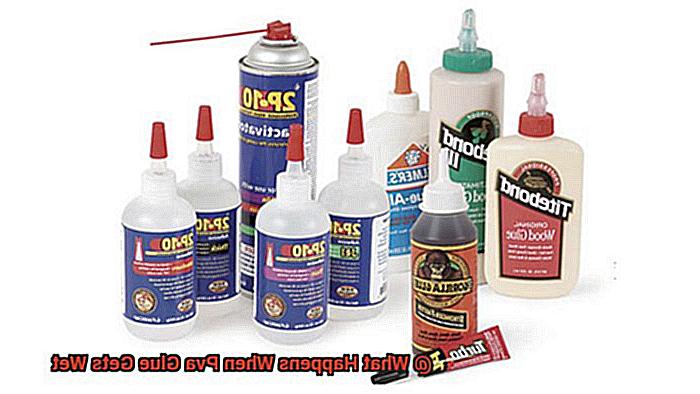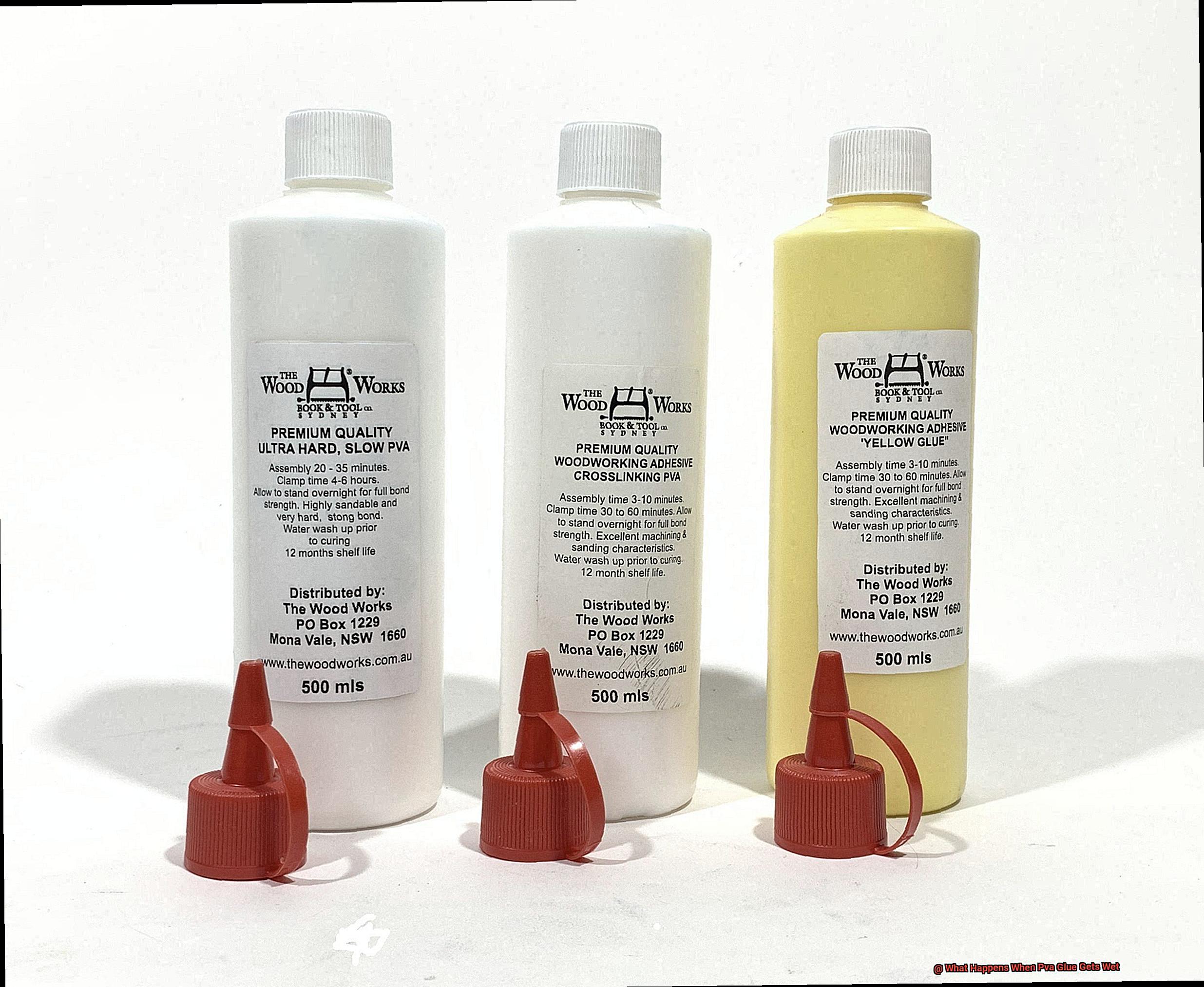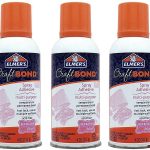Are you a DIY enthusiast who loves using PVA glue in your projects? If so, you may have wondered what happens to this versatile adhesive when it gets wet. In this blog post, we’ll dive into the fascinating transformation that occurs when PVA glue comes into contact with moisture.
Did you know that PVA glue is made up of tiny particles suspended in water? When exposed to water, these particles absorb the moisture and cause the glue to swell and soften. This can lead to weakened adhesion, compromising the stability and durability of your project.

But don’t worry – there’s a solution for those who need to use PVA glue in damp or humid environments. Waterproof PVA glue is specifically designed to withstand moisture and maintain its adhesive properties.
In this post, we’ll explore various factors that can affect how PVA glue reacts to water, such as temperature, humidity, and exposure time. We’ll also provide tips and tricks to help ensure your PVA glue-based projects stand the test of time.
Whether you’re a seasoned DIYer or just starting out, keep reading to learn everything you need to know about what happens when PVA glue gets wet.
What is PVA Glue?
Contents
- 1 What is PVA Glue?
- 2 How Does PVA Glue React When Wet?
- 3 Factors That Affect the Dissolution of PVA Glue in Water
- 4 The Chemical Reaction that Occurs When PVA Glue Gets Wet
- 5 How Does This Chemical Reaction Affect Adhesive Properties?
- 6 Other Effects of Getting PVA Glue Wet
- 7 Tips for Avoiding These Negative Effects
- 8 Conclusion
PVA glue, also known as polyvinyl acetate glue, is a versatile and widely used adhesive that has many applications in the crafting world. This water-based polymer is non-toxic and safe to use, making it a popular choice for children’s projects.
One of the biggest advantages of PVA glue is its ability to bond a wide range of materials, including paper, wood, and fabric. It dries clear, making it ideal for use in projects where the adhesive may be visible. Additionally, PVA glue has a long shelf life and can be stored at room temperature without deteriorating.
Another benefit of PVA glue is its ability to act as a sealant or varnish. When diluted with water, it can be applied to surfaces to create a protective layer. This makes it a popular choice for protecting delicate surfaces or providing a glossy finish to projects.
Despite its many advantages, one downside of PVA glue is its water-solubility. When exposed to water for an extended period of time, it can lose its adhesive properties and become ineffective. The chemical bonds that hold the glue together are broken down by the water, causing it to weaken and eventually dissolve.
To avoid this issue, it is important to keep in mind the potential for water exposure when using PVA glue in projects. If possible, use a waterproof or water-resistant adhesive instead to ensure that your project stays securely bonded even if it gets wet.
How Does PVA Glue React When Wet?
PVA glue is an adhesive that can bond a wide range of materials, but it has a major weakness – water-solubility. When exposed to water, it undergoes a chemical reaction that affects its adhesive properties.
The amount of water and the type of PVA glue are factors that determine how much the glue will react when wet. For example, some PVA glues are designed to be more water-resistant than others and may not react as much when exposed to water. However, in general, extended exposure to water causes PVA glue to soften and lose its adhesive strength.

This occurs because the water breaks down the glue’s polymer chains and makes them less cohesive, ultimately making it less effective at bonding materials together. But don’t fret. Some PVA glues are specifically designed for use in damp or humid environments and have increased water resistance. These types of glues may maintain their adhesive properties when exposed to moisture.
Factors That Affect the Dissolution of PVA Glue in Water
Today, we’ll delve into the fascinating world of PVA glue and explore the factors that influence its dissolution in water. PVA glue, also known as white glue or school glue, is a versatile adhesive that is commonly used in woodworking, construction, and arts and crafts. However, when PVA glue comes into contact with water, it can undergo a process called dissolution, which breaks down the glue’s molecular structure.
There are several factors that can affect the dissolution of PVA glue in water. First and foremost, the concentration of the glue plays a significant role in how long it takes to dissolve. The more concentrated the solution, the more challenging it is for water molecules to penetrate and interact with the adhesive molecules. Diluting your PVA glue with water before use can help speed up the dissolution process.
Another factor that impacts PVA glue dissolution is water temperature. Hot water dissolves PVA glue faster than cold water due to its increased kinetic energy. The faster-moving molecules are more likely to collide with and break apart the adhesive molecules, resulting in faster dissolution. So if you’re in a rush to dissolve your PVA glue, try using hot water.
The pH level of the water is another critical factor in PVA glue dissolution. PVA glue is slightly acidic, with a pH level between 4-If the water used to dissolve the glue has a higher or lower pH level than this range, it can affect the adhesive properties of the glue. Using water within this pH range will help maintain the best adhesive properties.
Other factors that can impact PVA glue dissolution include external factors such as humidity and air temperature, as well as the type of surface or material to which it is applied. In humid environments, moisture in the air can slow down PVA glue’s dissolution rate.
The Chemical Reaction that Occurs When PVA Glue Gets Wet
Well, wonder no more. As an expert on the topic, I’m here to provide a fascinating explanation of the chemical reaction that occurs and how it can impact your adhesive’s durability.
Let’s start with the basics. PVA glue is made up of a synthetic polymer called polyvinyl acetate, which can dissolve in water. When water comes in contact with the glue, a chemical reaction takes place. The water molecules are attracted to the polar groups in the polymer chains, causing them to separate and making the glue less viscous. This process, known as dissolution, causes the glue to become more fluid.
The good news is that this chemical reaction is reversible. Once the glue dries out, it can return to its original state and regain its adhesive properties. However, if PVA glue is exposed to water for an extended period of time, it may start to lose its adhesive properties and become weaker. This is because the water can cause permanent damage to the polymer chains’ integrity, leading to a loss of strength in the glue.
To improve PVA glue’s durability, manufacturers often add additives such as cross-linking agents or plasticizers. These additives can make the glue more resistant to water and other environmental factors, making it suitable for specific applications.
It’s also important to note that external factors like concentration, temperature, pH level, humidity, and surface type can affect PVA glue’s dissolution rate. Diluting your glue with warm water within a specific pH range can help maintain its adhesive properties in different environments.
How Does This Chemical Reaction Affect Adhesive Properties?
Polyvinyl acetate (PVA) glue consists of polymer particles suspended in water. When the glue dries up, the water evaporates, leaving behind a tight adhesive film. However, when the glue comes into contact with water again, the positive end of water molecules can weaken the negative charges on the polymer particles. This can lead to a breakdown in the bond between them and cause a loss of adhesive strength.
So, what can be done to prevent this issue from occurring? Manufacturers have developed waterproof or water-resistant versions of PVA glue that contain additional chemicals that strengthen the bond between the polymer particles. These glues can resist water exposure to a certain extent, but may still lose some adhesive strength over time.
Another way to improve PVA glue’s durability is by adding cross-linking agents or plasticizers. These additives can make it more resistant to moisture and less likely to lose its adhesive strength when wet. It’s also crucial to store your glue in a cool and dry place to prevent external factors like temperature and humidity from affecting its dissolution rate.
Other Effects of Getting PVA Glue Wet
PVA glue is a popular adhesive that can hold together a wide range of materials. However, when this glue gets wet, it can have some unintended effects that can undermine its effectiveness. Besides weakening its bonding strength, getting PVA glue wet can also cause it to turn white and opaque. This can be problematic for those in search of a clear or transparent adhesive.
Another effect of getting PVA glue wet is that it takes longer to dry than usual. This is because the water needs to evaporate before the glue can set properly, leading to extended drying times. So if you’re on a tight timeline, make sure the glue is completely dry before applying any pressure or weight to it.
Moreover, prolonged exposure to moisture or humidity can cause PVA glue to break down and lose its adhesive properties altogether. To keep your PVA glue in top form, store it in a cool and dry place.
To summarize, here are the other effects of getting PVA glue wet:

- Reduced bonding strength
- Opacity
- Longer drying times
- Potential for breakdown and loss of adhesive properties
Tips for Avoiding These Negative Effects
PVA glue is a versatile and popular adhesive that is used in various DIY projects. However, when it gets wet, it can lose its adhesive properties, become discolored, or even moldy. Here are some tips and tricks to avoid these negative effects:
Use a waterproof PVA glue:
Choosing a high-quality waterproof PVA glue is the best way to prevent it from losing its adhesive properties when exposed to water. These types of glues are perfect for outdoor projects or areas with high humidity.
Ensure the surface is clean and dry:
Before applying PVA glue, make sure that the surface is free from any dust or debris and completely dry. A clean surface will ensure that the glue adheres properly and remains strong even if exposed to water.
Apply a waterproof sealant:
If you are using regular PVA glue and need to protect it from water, you can apply a waterproof sealant over the top once it has dried. This additional layer of protection will help to keep the glue intact even if it comes into contact with water.
Store your PVA glue correctly:
To prevent your PVA glue from breaking down over time, store it in a cool, dry place away from direct sunlight and moisture. Exposure to sunlight or moisture can weaken the glue, making it less effective.
Dry glued items completely:
After gluing items together, make sure that they are completely dry before storing them. Failure to do so can cause mold or mildew growth on the glued surface, which can weaken the adhesive properties of the glue.
-42-ku-3ti0″ >
Also Read: Is white glue waterproof when dry?
Conclusion
In conclusion, PVA glue is a highly versatile adhesive that can be used to bond an array of materials. However, when it comes into contact with water, this popular adhesive undergoes a chemical reaction that can weaken its bond and compromise the stability of your project. The extent of damage caused by water exposure depends on various factors such as temperature, humidity, surface type, exposure time, and the amount of water.
To prevent the negative effects of water exposure on PVA glue-based projects, it is vital to use waterproof or water-resistant PVA glue in damp or humid environments. Additionally, ensuring that the surface is clean and dry before applying the adhesive and storing it correctly in a cool and dry place away from direct sunlight and moisture can help maintain its adhesive properties.
Moreover, cross-linking agents or plasticizers can be added to make PVA glue more resistant to moisture and less likely to lose its adhesive strength when wet. Applying a waterproof sealant over the top once the glue has dried provides additional protection against water exposure.
By following these tips and tricks, you can guarantee that your PVA glue-based projects remain securely bonded even if they come into contact with water.






